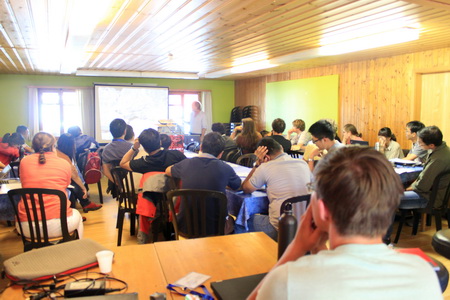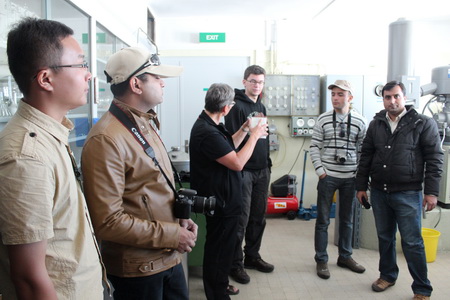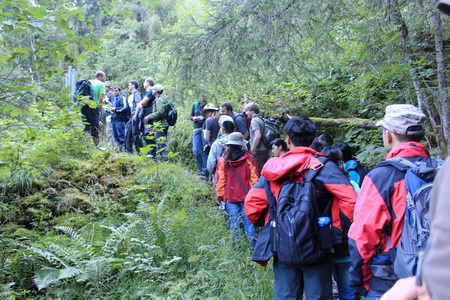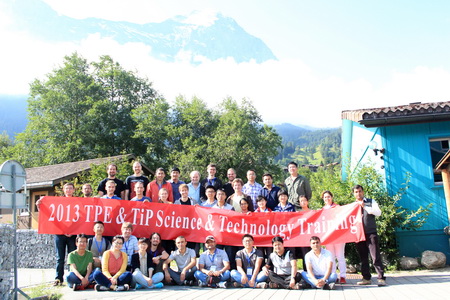| News |
| Latest news | |
| Int’l Cooperation activities | |
| Events & Announcement | |
| Recent Activities |
| Location: Home>News>Recent Activities |
| TPE joined hands with TiP in holding Summer School in Grindelwald (Switzerland) |
August 11 to 19, 2013, the third international Summer School in the frame of the TPE Program (Third Pole Environment) and the German TiP Program (Tibetan Plateau: Formation – Climate – Ecosystems) was held in the village of Grindelwald in the Bernese Alps. Thirty-one students were selected to attend the summer school, including ten Chinese and eleven German students, in addition to ten students from the TPE program (Nepal, India, Pakistan, Tajikistan, Kazakhstan, Kyrgyz, and Iran).
The summer school started with an icebreaker excursion to the valley of the Lower Grindelwald Glacier (G. Stauch, RWTH Aachen). This glacier has the lowest glacier terminus in the European Alps and is probably the best monitored glacier in the world. The position of glacial terminus has been recorded every year since 1879. Additionally numerous glacial landforms are preserved in the valley. The excursion provided practical and fundamental knowledge for the following lectures.
On the second day Sven Lukas (Queen Mary University, London) provided a comprehensive overview on glacial geomorphology. Special emphasis was placed on the sedimentology of glacial sediments with numerous examples from the European Alps, Svalbard, Scotland and Norway. In a practical exercise the participants measured and described the clast shape of different small clasts from the surrounding area.
The following day Douglas I. Benn (University Centre, Svalbard) introduced several concepts in glaciology. Topics ranged from glacial mass balance and heat transfer to glacier thermal regime and glacial hazards. He also presented some of his research results from the glacier ice – glacier bed interaction from Svalbard as a special highlight. On Day 4, Zhongqin Li (CAREERI, Lanzhou) gave a lecture about research programs at different Chinese glaciers in the morning, and Dongmei Qu and Fan Zhang (Institute of Tibetan Plateau Research, Beijing) introduced, respectively, stable isotope analysis of ice cores and the TPE program In the afternoon. Day 5 and Day 6 witnessed lectures on dendrochronology by Achim Bräuning (University of Erlangen) and introduction to time series analysis by Manfred Muddelsee (Climate Risk Analysis, Hannover). Dr. Bräuning touched upon the subject from the basic wood anatomy and the dating of tree rings, and then explored possible interplays between tree rings and climate parameters. He also introduced some principles in tree ring sampling during a short field trip to nearby forest. While Dr. Muddelsee explained the different parameters of palaeoclimate time series before elaborating on different analysis concepts and methods including persistence models, bootstrap intervals and regression analysis.
The summer school also included an excursion to the nearby Jungfraujoch in the interim of the program and a barbeque at the end. Afterwards, all participants were also invited to participate in the 2013-HKT-ISTP Conference(28th Himalayan Karakorum Tibet Workshop and 6th International Symposium on Tibetan Plateau Joint Conference)in Tubingen, Germany, from the 12th to the 25th August 2013.
The Tibetan Plateau comprises the largest glaciated area in the world outside the Polar Regions and glaciers are an important part of the Tibetan geo-ecosystem. Glaciers from this area and the bordering mountains concern livelihood of two billion people. This summer school mainly dealt with different aspects of glaciers and glaciations as well as related aspects. It provided a good oppotunity for young scholars to cultivate friendship with each other, and get more interested in their research subjects. |




